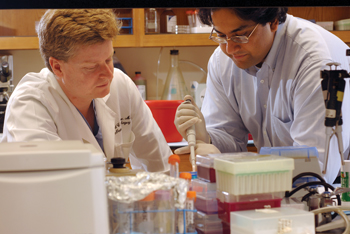
Reid Thompson, M.D., left, and Moneeb Ehtesham, M.D., are studying how aggressive brain tumors spread.
photo by Anne Rayner
Investigators study tumor’s progression
Vanderbilt-Ingram Cancer Center investigators are shedding new light on one of the factors that controls the swift spread of glioblastoma multiforme, a rare and very aggressive brain tumor.
“It is one of the most rapidly progressive of all human cancers. Despite our best efforts to treat these tumors, including surgery, radiation and chemotherapy, it is unusual for patients to survive beyond two years,” said Reid Thompson, M.D., director of Neurosurgical Oncology.
So, Thompson and his colleague, Moneeb Ehtesham, M.D., assistant professor of Neurological Surgery and Cancer Biology, set out to find out what is governing the invasion process in glioblastomas and how to stop the spread of the deadly disease.
“We thought it would be worth exploring the molecular measures in glioma cell invasion. We looked at CXCR4, a molecule that has been shown to play a role in other cancers, and found that the more metastatic aggression relates to this molecule. So, we looked at whether this molecule governed this invasion in gliomas,” said Ehtesham.
CXCR4 is a receptor found in white blood cells and has been shown to play a key role in regulating the movement of cells in the immune system. Finding something to inhibit CXCR4 could potentially lead to treatment options to prevent cancerous cells from moving to other organs.
Thompson and Ehtesham's hunch about CXCR4's role in aggressive brain tumors proved true, and their results are presented in a paper released Jan. 9 in the online edition of the journal Oncogene. In animal models, the researchers found CXCR4 can, in fact, be linked to cell invasion in glioblastoma.
“If we look at a brain cancer model in rodents we can see a difference in CXCR4 expression in invasive and non-invasive cells. We found CXCR4 was expressed in the non-invasive cells, but was much higher in invasive cells, or cells from the core of the tumor and cells that had migrated away,” said Ehtesham. Thompson said it was significantly higher, “up to thirty- to fortyfold higher in the invasive cells,” he added.
Next, Thompson and Ehtesham looked at CXCR4 more closely, in dish studies. They wanted to determine whether cells that have CXCR4 invade more than cells without the molecule. They induced glioblastoma and forced the cells to migrate, comparing migrating brain tumor cells with the cells at the origin of the cancer. Their findings were consistent with the animal studies; CXCR4 was again much higher in the migrating cancer cells than in the core of the tumor. Only this time, even higher — sixty- to eightyfold higher, according to Ehtesham.
The researchers then shut down the CXCR4 function of the receptor. What they found was puzzling. Shutting it down significantly weakened its ability to migrate, but it didn't stop it altogether. “Cancer is finding a way to move around the brain, said Thompson. “This tells us this receptor plays an important role in mediating cell invasion of gliomas,” he added.
Ehtesham said it is one of the contributors, but there are many others. The discovery could help experts target new therapies for the aggressive brain tumors. Several studies are under way to look at targeting molecules to specifically shut down CXCR4 for other cancers, but Thompson said no one has linked its expression to the invasive behavior of brain tumor cells, until now. Ehtesham said they are now looking at a neutralizing antibody that binds to CXCR4 and works by sequestering the invasive molecule, as well as small-interference RNA, which is like silencing it by shutting down the expression of the receptor.
“Now we may have a way of blocking the process that allows cancer to spread in the brain, but we will need to know more than just how to shut down these migratory cells to fight this cancer. This is just another tool in our arsenal,” said Thompson.
He said he and Ehtesham are eager to take this research into human trials soon and hope to see benefits for the approximately 18,000 Americans facing a newly diagnosed glioma each year. “We're really interested in taking this information and rapidly translating it to patients,” said Thompson.













